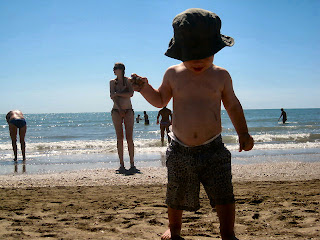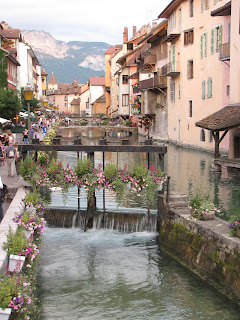Never having had a garden large enough for anything more than a few tomato plants, beans, peppers, radish and salad, I wasn’t exactly sure what potato harvesting entailed. From literature I knew they grew from “seed potatoes” which are pieces of the potato, and that harvesting can be labor-intensive.
As I explained in my previous post, our visit to see friends in Chatenet resulted in a potato harvest and a bag of goodies for us to take home. And that is how I came to be in the garden digging potatoes 18 weeks pregnant! It was actually easier than I had imagined, Nigel worked the ground, turning over the roots of the dead plants, and I plucked the potatoes out. Ever year he saves a few potatoes of each variety, chops them up for seed potatoes, and plants them in neat little rows. The importance of the neat rows, and of marking the start and end of each row and variety, became clear in the garden. The green potato plants are long gone at harvest time; in fact while the plant is still living, the tubers are still growing.
We came home in abundance with the variety that did remarkably well this year, vitelotte. Yesterday I spent quite some time washing them, as well as the beets and carrots that we had been gifted. Then started the beet soup preparation; little did I know what I was in for!
I decided to use the recipe I found online here, partly because I had access to most of the ingredients, but mostly because of all the nice pictures, encouraging me that I’m following instructions correctly if my results look similar to the pictures. To my non-Latvian speaking readers, I’ve translated the recipe down below. However, I ran into quite a few snags including lack of availability of some ingredients (and hence, substitutions), uncertainty on some quantities of ingredients, and fatigue when I still hadn’t finished by 11pm.
The beets cooked exactly as they should, and the skins came off very easily. Then - my first liberty with the recipe, not clear on what 200 grams of cooled beet broth would be, I simply used enough to completely cover the chopped beets. I then skipped the chives, adding only dill and parsley (parsley from my balcony garden, dill from Carrefour, and again, not quite clear on quantities), skipped the milk sausage (any recommendations for substitutes out there?), and because I have yet to find kefir in the stores here, I added crème fraîche épaisse (clotted cream, used in several other cold soups).
With only these minor deviations my bowl looked nothing like the lovely pictures on fotoreceptes.com. I took quick action, adding a little milk and some water in order to make more of a soup than a beet salad. The rest of the recipe I followed to a T, and then Roberts came in for a visual inspection. “Smells right, right color” was the initial verdict.
I should also include the following warnings:
1. My hands are still stained red, two days later.
2. Beet juice will stain wood, plastic utensils and other surfaces, operate with care.
3. The resulting pink color is not easily found in nature, unless pepto bismol qualifies as nature.
4. The recipe results in enough soup for two dinners, so I will be freezing some.
And so, the following night we had beet soup for dinner. Or shall I say, Roberts and Lauris had beet soup for dinner. Final verdict? “Visually: Perfect color. Professional presentation with the touch of parsley on the side. Taste and Texture: Slightly larger beet and potato pieces than previously experienced, while the radishes are almost too finely-cut to notice. Would add some chives. This was the best beet soup ever thank you honey you are the best.”
************
Cold beet soup
* The original recipe did not mention quantities for some ingredients and I took the liberty of including here the measurements I used.
6 beets
4 small cucumbers
kefir
milk sausage (? not sure how to translate…. I skipped this because I’m not a fan)
4 potatoes
4 eggs
a bunch of radish
chives, dill and parsley
mustard
one lemon
pepper, salt and sugar
4 small cucumbers
kefir
milk sausage (? not sure how to translate…. I skipped this because I’m not a fan)
4 potatoes
4 eggs
a bunch of radish
chives, dill and parsley
mustard
one lemon
pepper, salt and sugar
1. Wash the beets after removing the leaves, put them in a large pot and heat to boiling, then reduce heat and let simmer for about an hour.
2. To preserve the color and taste, drop the boiled beets into a bowl of cold water.
3. While the beets are cooling, wash four large potatoes and then boil those.
4. When the beets are cool, trim the ends and remove the skin, then cut into small pieces.
5. Take enough of the cooled beet broth to cover the beets and add a teaspoon of salt, two teaspoons sugar and the juice of one lemon, then pour over beets and let sit for two hours
6. Once the potatoes are ready, peel and cut them into small cubes. They can be added to the beets when done marinating.
7. Finely chop the chives, dill and parsley (note: I used only dill and parsley as I could not find chives) and add to the mix.
8. Chop up the milk sausage and add that as well.
9. Add 1 L of kefir, mix thoroughly.
10. Chop the cucumber, add that.
11. Boil the eggs, peel and chop them (into semi-large pieces) as well before adding.
12. The radish also gets chopped into small pieces before being added.
13. Mix well, then refrigerate overnight.
14. For a little extra sharpness, add some mustard.
Voila!








































